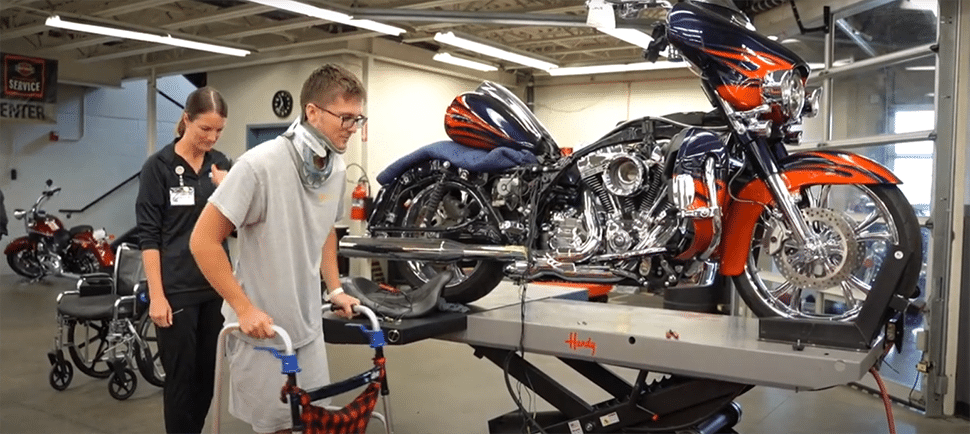Cole Bottger’s life revolves around his need for speed. When he’s not on one of his motorcycles, he’s working at Dillon Brothers Harley-Davidson as a technician.
“I started off with dirt bikes and my dad was a Harley guy, so I just grew up around them,” Cole said.
On his way home from work one July evening, Cole says he remembers stopping to fill up on gas, then waking up in a hospital bed at Nebraska Medicine. He had been struck by a car at an intersection while riding his motorcycle. He sustained several broken bones and a spinal cord injury as a result. However, thanks to his helmet, he did not have serious brain trauma.
“No brain injury, not even a concussion,” he said. “My helmet has scrapes on it, but for getting hit at 45 miles an hour, it could’ve been a lot worse. I still have all my noggin, so that’s always good.”
Cole came to Madonna Rehabilitation Hospitals to heal and regain strength in his affected limbs. Between a neck brace to correct a fractured C7 vertebrae and pain from a broken femur and broken arm, pain limited his mobility.
“He was definitely hesitant at first because the things we ask patients to do in therapy can be scary and very intimidating at first,” Kaylee Wallace, OTR/L, CLT, Cole’s occupational therapist, said. “We ask them to really trust us and try to get to know them on a personal level, which helps build that rapport as well.”
Still, Wallace was surprised to hear Cole didn’t have any brain injuries after his crash. She says it highlights the need to always wear your helmet. Wallace and Cole bonded over their love of motorcycles and, through Madonna’s Work Re-Entry Program, found ways to simulate his work environment during therapy sessions.
“Obviously we always work on things we need Cole to do to be able to go home and go back to the way his life was before, but we also want to incorporate what patients’ personal goals are, and for Cole, that was getting back to work. He loves his job. I knew right from the get-go that would be a focus of ours, to get him back on his feet, to get his arm working, so he can do those mechanical-type tasks and get back to work.”
Assembly tasks, like a pipe tree and snap circuits, challenged Cole both physically and mentally. He improved his cognition while fine-tuning his balance and stamina.
“The circuits especially are very similar to what he does at work,” Wallace said. “It involves electricity, organization, planning, problem-solving, building things and taking them apart. If there’s an error, he has to figure that out and fix it, so it was perfect.”
The final step to ensuring Cole could safely return to work was a trip to his Harley-Davidson dealership. Wallace says she picked it as a therapeutic outing in conjunction with recreation therapy because it allowed Cole to get comfortable with the idea of returning to work, build his confidence, and to lift his spirits.
“Never thought I’d say I missed work, but I guess I did,” Cole said. “We’re a big family there and everybody cares about each other, which makes it fun.”
Less than a month after his accident, Cole and his employer were anxious to get him back on the job. He was able to step into a modified role as his body continues to heal.
“These guys are like, ‘We’ll find you something really light to do. You can go slow. We just want you there,’ which is awesome,” Cole said. For Wallace, that moment with Cole made an impact she’ll always remember.
“That’s the biggest reward you can have as a therapist, to see that and know your patient is going to be able to do what they want to do and the things they were doing prior to their accident,” Wallace said.






